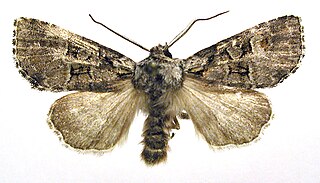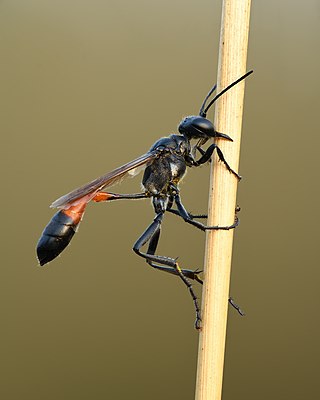| Faronta | |
|---|---|
 | |
| Faronta diffusa | |
| Scientific classification | |
| Kingdom: | |
| Phylum: | |
| Class: | |
| Order: | |
| Family: | |
| Genus: | Faronta Smith, 1908 |
Faronta was a genus of moths of the family Noctuidae. It is now considered a synonym of Dargida .
| Faronta | |
|---|---|
 | |
| Faronta diffusa | |
| Scientific classification | |
| Kingdom: | |
| Phylum: | |
| Class: | |
| Order: | |
| Family: | |
| Genus: | Faronta Smith, 1908 |
Faronta was a genus of moths of the family Noctuidae. It is now considered a synonym of Dargida .

Wasps of the genus Sphex are cosmopolitan predators that sting and paralyze prey insects. Sphex is one of many genera in the old digger wasp family Sphecidae, though most apart from the Sphecinae have now been moved to the family Crabronidae. There are over 130 known Sphex species.

Sceliphron, also known as black mud daubers or black mud-dauber wasps, is a genus of Hymenoptera of the Sphecidae family of wasps. They are solitary mud daubers and build nests made of mud. Nests are frequently constructed in shaded niches, often just inside of windows or vent openings, and it may take a female only a day to construct a cell requiring dozens of trips carrying mud. Females will add new cells one by one to the nest after each cell is provisioned. They provision these nests with spiders, such as crab spiders, orb-weaver spiders and jumping spiders in particular, as food for the developing larvae. Each mud cell contains one egg and is provided with several prey items. Females of some species lay a modest average of 15 eggs over their whole lifespan. Various parasites attack these nests, including several species of cuckoo wasps, primarily by sneaking into the nest while the resident mud dauber is out foraging.

Pison is a cosmopolitan genus of wasps within the family Crabronidae. The genus comprises 145 described species, although many species, especially in South America remain undescribed.

Acronicta is a genus of noctuid moths containing about 150 species distributed mainly in the temperate Holarctic, with some in adjacent subtropical regions. The genus was erected by Carl Linnaeus in his 1758 10th edition of Systema Naturae. Caterpillars of most Acronicta species are unmistakable, with brightly colored hairy spikes, and often feed quite visibly on common foliate trees. The hairy spikes may contain poison, which cause itchy, painful, swollen rash in humans on contact. The larva of the smeared dagger moth is unusually hairy even for this genus. Acronicta species are generally known as dagger moths, as most have one or more black dagger-shaped markings on their forewing uppersides. But some species have a conspicuous dark ring marking instead.

Apamea is a genus of moths in the family Noctuidae first described by Ferdinand Ochsenheimer in 1816.

Ixodes is a genus of hard-bodied ticks. It includes important disease vectors of animals and humans, and some species inject toxins that can cause paralysis. Some ticks in this genus may transmit the pathogenic bacterium Borrelia burgdorferi responsible for causing Lyme disease. Additional organisms that may be transmitted by Ixodes are parasites from the genus Babesia, which cause babesiosis, and bacteria from the related genus Anaplasma, which cause anaplasmosis.

Larra, also known as mole cricket wasps or mole cricket hunters, is a genus of wasps that prey on various species of mole crickets. They have gained prominence as integrated pest management agents.

Acontia is a genus of moths of the family Noctuidae. The genus was named by Ferdinand Ochsenheimer in 1816. Eusceptis, Pseudalypia and Spragueia are sometimes included in the present genus, but here they are tentatively treated as different pending further research. Many species of Tarache were also once placed here.

Brachylomia is a genus of moths of the family Noctuidae.

Condica is a genus of moths of the family Noctuidae. The genus was erected by Francis Walker in 1856.

Dargida is a genus of moths of the family Noctuidae.

Eriopyga is a genus of moths of the family Noctuidae. The genus was erected by Achille Guenée in 1852.

Leucania is a genus of moths of the family Noctuidae first described by Ferdinand Ochsenheimer in 1816.

Sideridis is a genus of moths of the family Noctuidae raised by Jacob Hübner in 1821.

Ammophila is the type genus of the subfamily Ammophilinae of the hunting wasp family Sphecidae. Ammophila is a large and cosmopolitan genus, with over 200 species, mostly occurring in the warmer regions of all continents apart from Antarctica.

Tachytes is a genus of predatory, solitary wasps, containing about 300 species.
Podium is a genus of thread-waisted wasps in the family Sphecidae. There are at least 20 described species in Podium.